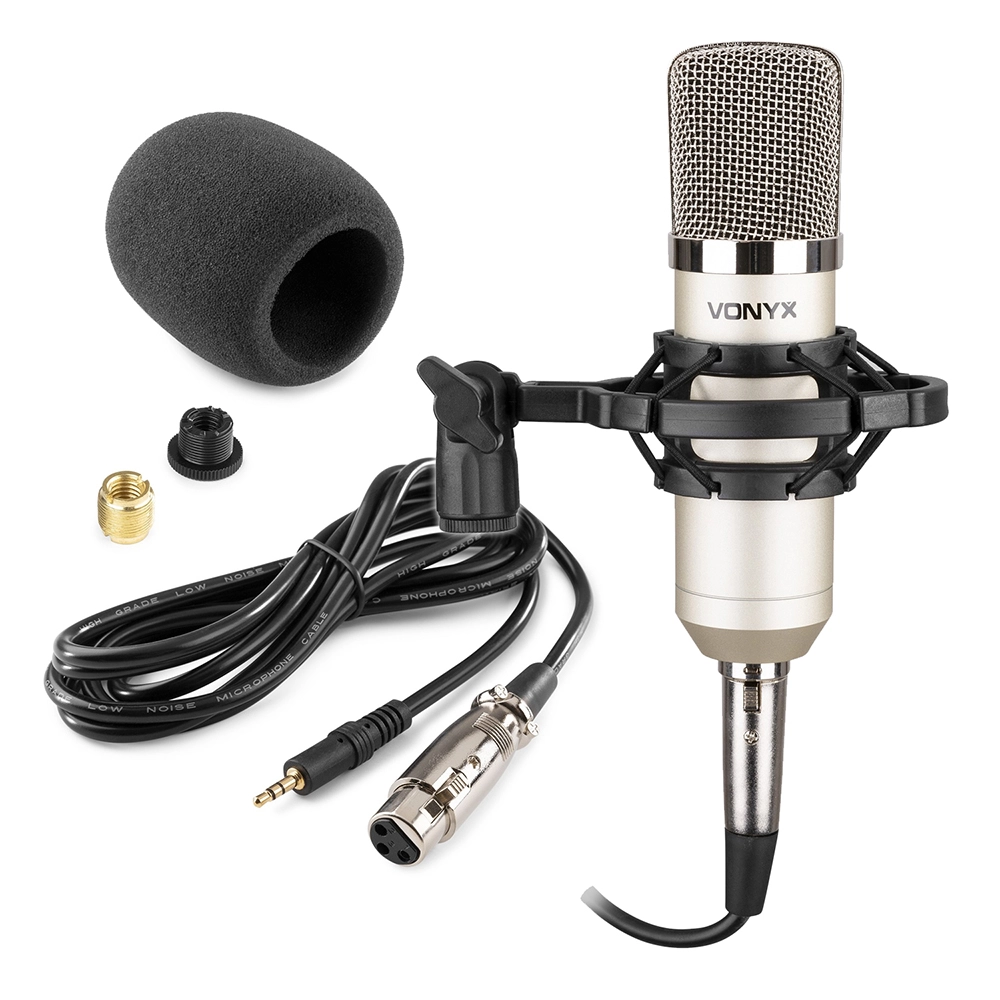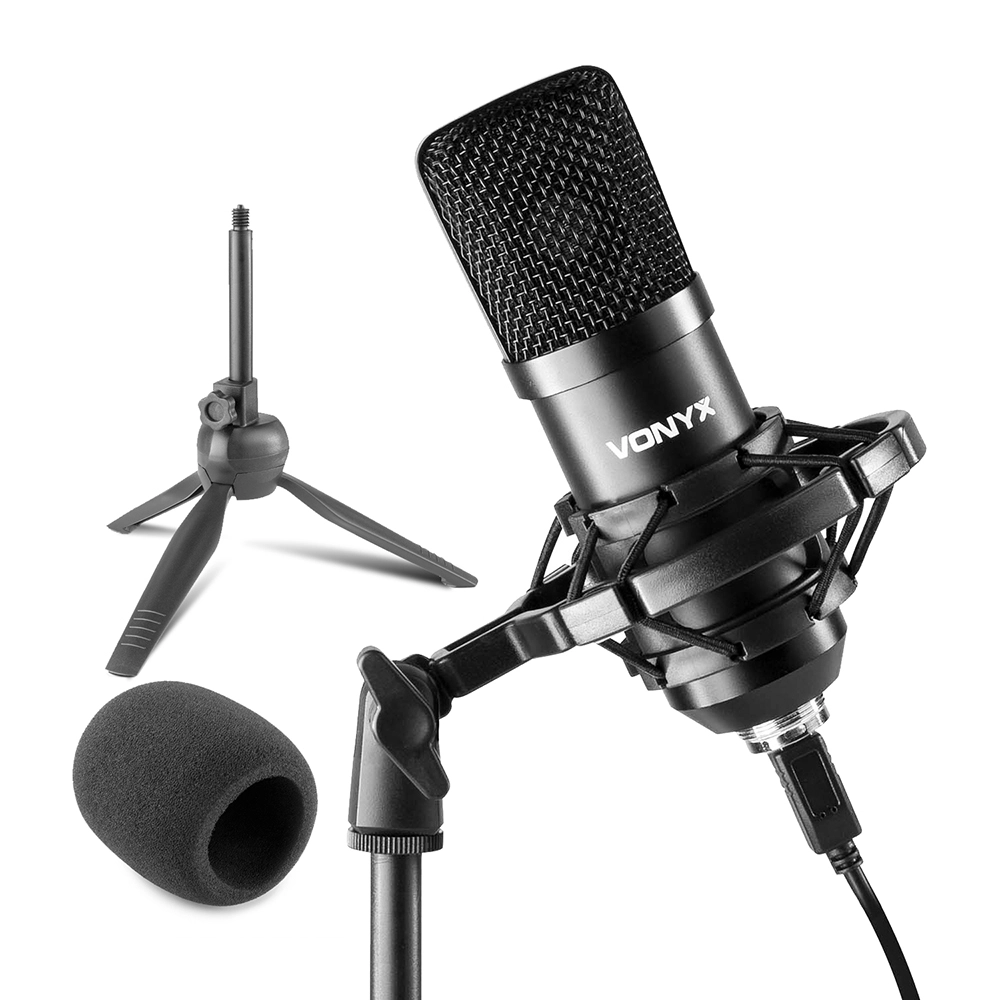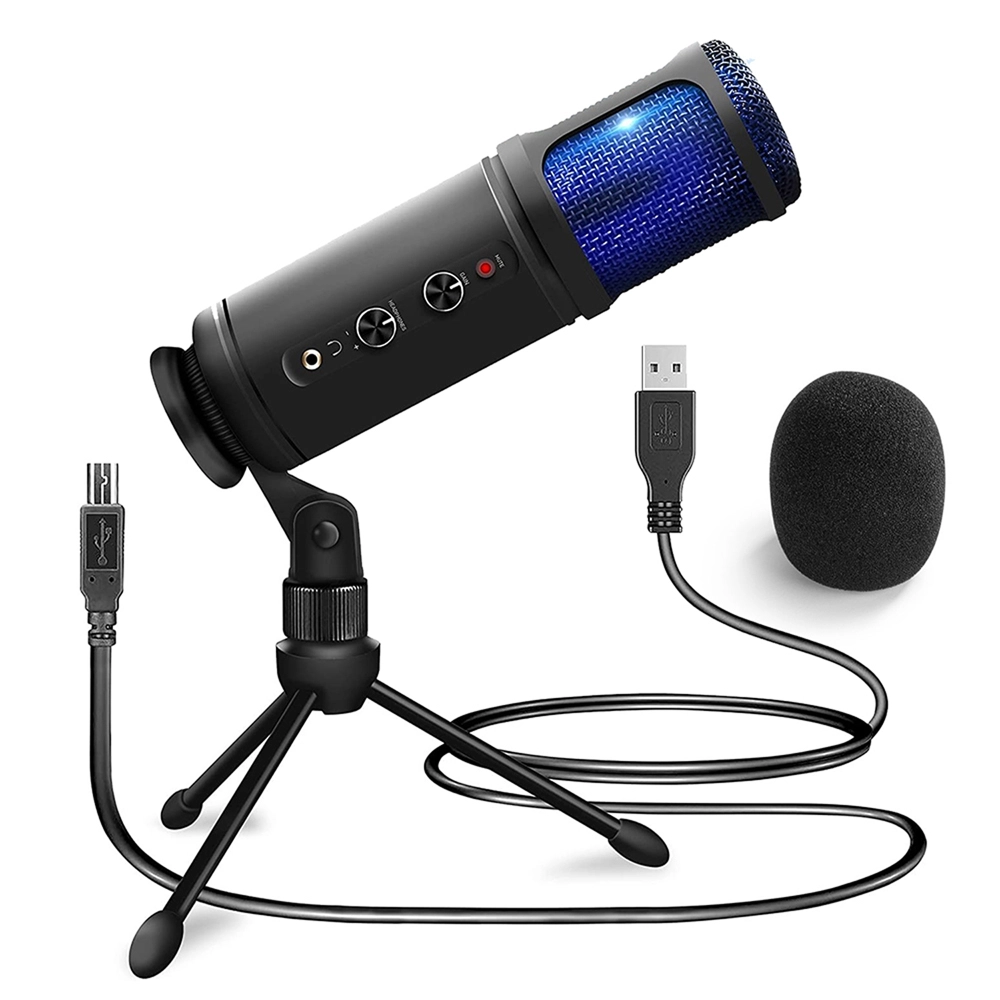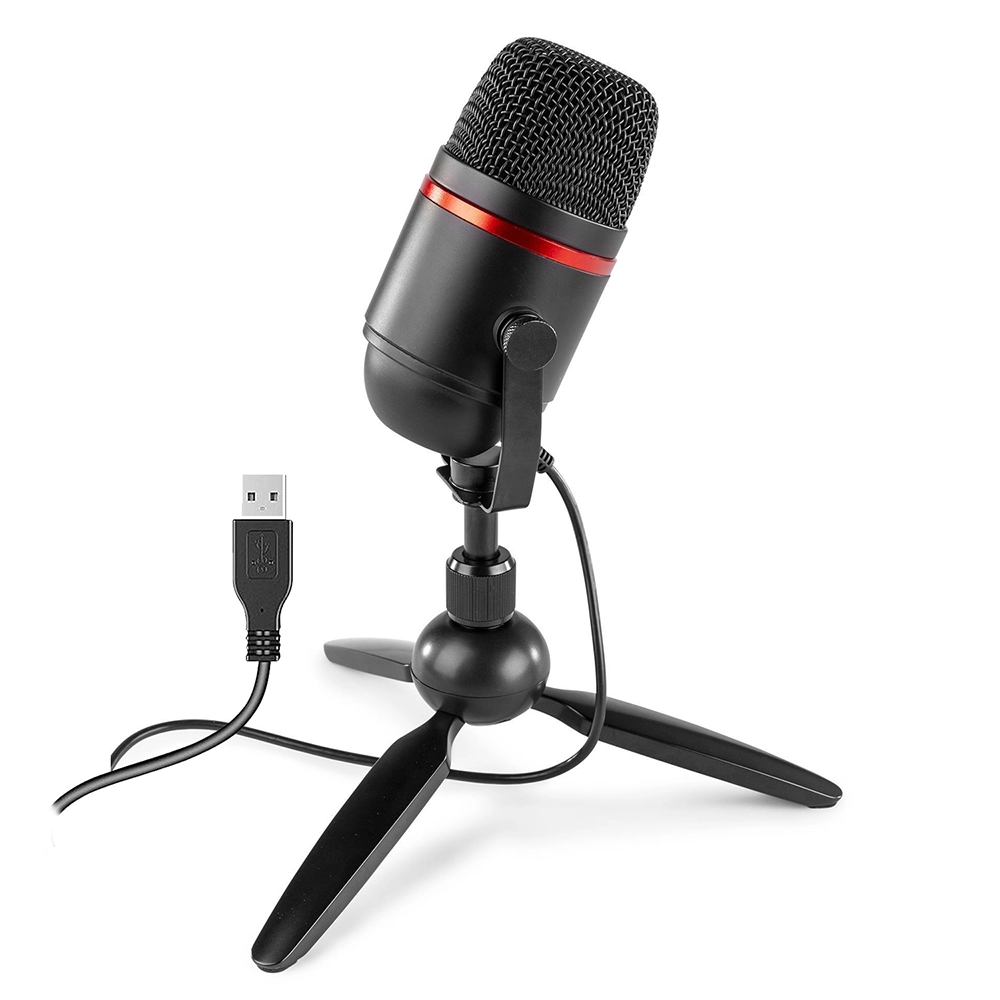Vonyx CM400 Studio Condenser Microphone Silver
The Vonyx CM400 Studio Condenser Microphone is a high-quality and stylish option, ideal for studio recording and live performances. It features a large diaphragm and a wide frequency response range of 60-15,000 Hz, ensuring crisp and clear audio reproduction.
This microphone produces excellent tone quality and sound reproduction, perfect for recording vocals and acoustic instruments. It also comes with a shock mount with a damping function and a pop filter, which helps to reduce unwanted noise and distortion.
Furthermore, it has an attractive look, with a silver/chrome case, and is also available in an eye-catching black/gold finish. The metal casing is also highly durable, providing long-lasting performance. Plus, it comes with a 2.5-metre XLR to 3.5mm jack cable, enabling it to connect easily to a mixer or computer.
The Vonyx CM400 Studio Condenser Microphone is a versatile and affordable option for musicians, podcasters, and content creators. Whether you're recording vocals, instruments, or podcasts, it will deliver professional-quality sound.
Key Features
- Large diaphragm condenser microphone
- Wide frequency range that picks up every nuance of the sound
- Includes shock mount with damping function, and pop filter to enhance sound quality
- Supplied with XLR to mini jack cable to easily connect to PC or mixer
- Stylish and robust metal casing for long-lasting performance
Pros
- Wide frequency range
- Includes shock mount and pop foam filter
- Durable and attractive metal casing
Cons
- Does not include a tripod stand
Vonyx CM300 Condenser Studio Microphone, Black
If you are looking for a highly affordable option, look no further than the Vonyx CM300 condenser microphone. This sleek microphone is available in black or silver and comes at a low cost. It is a great choice for clearly capturing vocals, acoustic instruments, and podcasts.
With an impressive frequency response of 30Hz to 20.000Hz, this condenser microphone ensures that your recordings sound natural and full. It also has a sensitivity of -36dB, allowing it to capture even the quietest of sounds.
In addition, a shock mount, folding tabletop desk stand, and pop filter are included with this microphone, so you have everything needed to get started. It also comes with a USB cable, making it easy to connect the mic directly to a PC or laptop. Whether you're a seasoned professional or just starting out, this is a reliable and versatile option for your recordings.
Key Features
- High-quality condenser microphone
- Impressive frequency response of 30 - 20.000Hz
- Features USB output to easily connect to a computer or laptop
- Supplied with a pop-filter and shock mount to enhance sound quality, plus a folding tabletop desk stand
- Built to last with durable metal casing
Pros
- Features shock mount with damping function and pop filter
- Includes foldable tabletop desk stand
- USB plug-and-play connectivity
Cons
- The microphone itself does not include inbuilt volume controls
Vonyx CM320S Studio USB Microphone with Echo & Desktop Stand
If you are searching for a versatile condenser microphone, the Vonyx CM320S Studio USB Microphone is a perfect choice. This microphone delivers professional quality sound and features a built-in sound card and USB cable, enabling it to connect directly to a computer, so you can record with ease.
One of the biggest selling points of this microphone is that it features adjustable volume and echo effect controls. This enables you to easily adjust the settings to suit your preferences during live performances. In addition, the microphone features a 3.5mm headphone connection, allowing you to connect a set of headphones directly to the microphone so you can hear your voice clearly.
Furthermore, there is a convenient mute button. This means you can quickly and easily stop the microphone from picking up sound, and then resume again when you are ready.
The microphone has a classic look, with a robust metal casing, and is available in titanium and black. It comes with a foldable desktop stand, and a foam pop filter to improve the overall sound quality.
Key Features
- Studio microphone with an inbuilt sound card and USB connection
- Includes adjustable volume and echo effect controls
- Mute button to easily stop and start the microphone picking up sound
- Headphone connection for live monitoring
- Equipped with foldable tripod stand, and foam filter
Pros
- Includes headphone connection, enabling live monitoring
- Features adjustable volume and echo controls, plus a mute button
- USB connection and built-in soundcard for direct PC connection
Cons
- Does not feature separate headphone volume control
Power Dynamics PCM120 USB Condenser Microphone with Stand
The Power Dynamics PCM120 USB Condenser Microphone is a must-have for anyone seeking a high-end, easy-to-use recording solution. This microphone provides exceptional performance, and its USB connection allows you to connect directly to your PC or laptop, eliminating the need for additional equipment.
A headphone connection allows you to plug your headphones directly into the microphone, so you can listen back in real-time. Plus, there are separate microphone and headphone volume dials, enabling you to easily adjust the levels to get the perfect recording. The mute button is also a great addition, allowing you to silence the mic when you need to talk to someone without broadcasting to your audience.
The included adjustable desktop tripod stand provides stability and reduces vibration noise, ensuring clear and precise recordings. The stand is foldable, and the angle can be adjusted to suit your preferences, making it perfect for home studio setups.
Key Features
- USB connection to plug the microphone straight into a PC or laptop
- Headphone connection for audio playback in real-time
- Adjustable microphone and headphone volume controls
- Mute button to stop recording at any time
- Adjustable desktop shock mount stand provided
Pros
- Separate microphone and headphone volume controls
- Easy to use mute button
- Adjustable and foldable tripod stand supplied
Cons
- Higher price point than some alternatives
Power Dynamics PCM100 USB Recording Microphone with Stand
Alternatively, if you are looking for a condenser microphone with a compact design for portability and to suit small spaces, consider the Power Dynamics PCM100 USB Recording Microphone. The design of this microphone means that it can easily fit in tight spaces, and it is simple to transport.
This microphone features a USB connection and comes with a USB cable, allowing you to connect it to your PC without the need for any additional equipment, such as a mixer. Its plug-and-play design makes it an excellent choice for beginners or experienced users who want a straightforward setup.
Additionally, the included tripod mount stand ensures that any vibrations are minimised, producing high-quality recordings. Overall, this microphone is a great choice for anyone looking for a high-quality, easy-to-use recording microphone.
Key Features
- Condenser mic with cardioid polar pattern to reduce background noise
- USB connection to plug the microphone directly into a PC, and USB cable provided
- Compact design for easy transport and placement in tight spaces
- Wide frequency response of 30Hz-18.000Hz
- Adjustable shock mount desktop stand included, reducing unwanted vibrations for high-quality recordings
Pros
- Compact design for portability and placement in any space
- Suitable for easy plug-and-play use
- Includes adjustable tripod desktop mount
Cons
- Does not feature inbuilt mute button
Summary
In conclusion, if you're an aspiring musician, podcaster, or content creator, having a high-quality microphone is essential to capture sound clearly. Finding the perfect condenser microphone can be a daunting task, however, this list of the best budget condenser microphones has hopefully helped you to make an informed decision.
Each microphone is an excellent choice for recording music, podcasts, and other content, providing a high-quality performance at an affordable price. The majority come with a shock mount, desktop tripod stand, and a pop filter, so you have everything needed to begin producing high-quality recordings.
To find your ideal condenser microphone, consider your particular needs. For instance, if you would like a microphone that features a mute button and inbuilt volume controls, the Vonyx 320S and the Power Dynamics PCM120 are both excellent options.
Alternatively, if affordability is the most important factor to you, the Vonyx CM300 is a great option. While, the Vonyx CM400 is a good choice if you prefer an XLR to mini jack connection, to a USB connection, and the Power Dynamics PCM100 is ideal if you seek a compact, portable mic.
Overall, each of the five microphones on our list delivers high-quality sound without breaking the bank. Whether you're recording acoustic music in your bedroom or hosting a podcast in a studio, there is a microphone here for you.
If you would like any assistance finding a cheap recording microphone, please do not hesitate to get in touch with our expert team.
Frequently Asked Questions
What is a condenser microphone?
A condenser microphone uses a charged diaphragm to convert sound waves into an electrical signal that can be amplified. They provide a wide frequency response and can pick up the slightest of sounds. As a result, condenser microphones are a popular choice for recording speech, singing, and acoustic instruments.
What are condenser microphones used for?
Condenser microphones are commonly used in studio recording and broadcast applications where high-quality audio is essential. They are great for capturing vocals and acoustic instruments, as their high sensitivity and wide frequency response pick up a lot of detail. Condenser microphones are also popularly used in podcasting, live streaming, and YouTube videos, as they provide a clear and professional sound.
How are condenser and regular microphones different?
Condenser and regular (dynamic) microphones both convert sound into an electrical signal, however, they do this differently. Regular microphones use a moving coil and magnet, while condenser microphones use an electrically charged diaphragm. As a result, condenser microphones are more sensitive and have a wider frequency response. Condenser microphones require external power (usually in the form of phantom power supplied by a mixer), while dynamic microphones do not require external power.
What is the difference between USB and XLR condenser microphones?
The key difference between a USB and XLR condenser microphone is that a USB mic connects directly to a PC or laptop, while XLR microphones need to be connected to a suitable mixer or audio interface. XLR microphones are often considered to provide superior sound quality, but USB microphones are much easier to use in home studio setups and are therefore often favoured by podcasters.
What kind of stand should I use when recording with a condenser microphone?
There are two popular choices of stand when recording content with a condenser microphone. Firstly, there are boom-arm style stands that can be mounted onto the edge of your desk using the clamping mechanism. This is great for studio use as you can easily adjust the microphone position. Alternatively, there are desktop stands which can simply be placed in front of you, and are easily moved as they don't need to fasten to anything.
Does a condenser microphone make you sound better?
Condenser microphones can in theory make your voice sound better, as they pick up the detail in your voice. Condenser microphones are more sensitive and have a wider frequency response than dynamic microphones. This can result in a more natural sound, suited to vocals and acoustic instruments.
Which is better, dynamic or condenser microphones?
Whether dynamic or condenser microphones are better will depend on your usage purposes. Condenser microphones are better suited to recording, because they tend to be more sensitive, with a wider frequency response. They are perfect for speech, singing and acoustic instruments. Whereas, dynamic microphones are a better choice for stage use and live performances, because they are more robust, and can handle higher volume levels without distorting.
How are condenser microphones powered?
Condenser microphones require a power source in order to operate, often known as phantom power. This power is usually supplied by an external source, such as a mixer or computer, and the power will be sent along the microphone cable. Many modern mixers are capable of providing phantom power, and this can be checked by taking a look at the features.
Are condenser microphones good for recording podcasts?
Yes, condenser microphones are a popular choice for recording podcasts due to their sensitivity and the high-quality sound produced. They are designed to capture detail, making them ideal for picking up the nuances in spoken-word content such as podcasts. However, condenser microphones are also very sensitive to environmental noise and room acoustics, so it is important to set up a quiet recording space.
Do you need a shock mount with a condenser microphone?
It is highly recommended to use a shock mount with a condenser microphone. Condenser microphones are highly sensitive to vibrations, and a shock mount helps to isolate the microphone from unwanted noises and vibrations such as bumps, and footsteps. Therefore, a clearer and more professional sound is produced. Many of our condenser microphones come with a sturdy shock mount.
The Origins of the Condenser Microphone
The first condenser microphone was invented in 1916 by E. C. Wente of Bell Labs. Wente was working on improving the telephone receiver and had the idea to use a capacitor, or condenser, to capture sound.
Condenser microphones work by using a thin, conductive diaphragm placed close to a metal plate, called a backplate, separated by a small air gap. When sound waves hit the diaphragm, it vibrates and changes the distance between the diaphragm and backplate, creating variations in the capacitance between them. This generates an electrical signal, which is then amplified and processed to create an audio signal that corresponds to the original sound waves.
Condenser microphones require an external power source, called phantom power, to operate. They are known for their sensitivity and accuracy, making them popular for recording podcasts, vocals and acoustic instruments, where high-quality sound is important.
The first condenser microphones were large and expensive, but they quickly became popular in the broadcasting and recording industries because of their superior sound quality and sensitivity. Over the years, the technology has been refined, making condenser microphones more affordable and accessible for a wider range of applications, from studio recording to computer gaming and podcasting.
Condenser vs Dynamic Microphones
Dynamic and condenser microphones are two common types of microphones used for various recording and audio applications. However, there are several key differences between the two.
Firstly, they operate differently. Dynamic microphones use a moving coil and a magnet to generate an electrical signal, while condenser microphones use a charged capacitor to create a signal. This means that condenser microphones require external power (usually in the form of phantom power supplied by an audio interface or mixer), while dynamic microphones do not require any external power.
Condenser microphones are generally more sensitive and responsive to changes in sound pressure than dynamic microphones, which tend to be less sensitive and better at handling high sound pressure levels. In addition, condenser microphones have a wider and more even frequency response than dynamic microphones, making them ideal for capturing high-frequency sounds such as vocals.
On the other hand, dynamic microphones are generally more rugged and durable than condenser microphones. As a result, they are a better choice for live sound applications where the microphone may be subjected to rough handling or accidental drops.
Overall, the choice between a dynamic and condenser microphone depends on the specific application and the desired sound quality. Dynamic microphones are often used for live performances, while condenser microphones are commonly used in studio recording and broadcast applications.
How to set up a condenser microphone?
The exact set-up process will differ between condenser microphones, as the connection options do vary between models.
The first step is to connect the condenser microphone to a suitable mixer, audio interface or computer with a suitable cable. Condenser microphones require phantom power in order to operate. Therefore, they will need to be connected to a device that can provide this power. The majority of modern mixers are capable of providing phantom power.
Some condenser microphones feature a USB connection, which means that they can connect directly to a computer or laptop. While others feature an XLR connection, meaning that they will need to be connected to a mixer or audio interface.
Next, mount your microphone onto a suitable microphone stand with a shock mount to eliminate unwanted vibrations. Ensure that the microphone is placed close to the sound source, and experiment with different positions to find the best sound.
Once your microphone is connected and powered, we recommend adjusting the microphone settings to suit your preferences. Test out the available settings while speaking/performing to achieve the best possible sound.
What accessories do I need with a condenser microphone?
The following accessories are popular when purchasing condenser microphones.
Firstly, as previously mentioned, a condenser microphone will require a suitable power source to provide phantom power. This may be a mixer or a computer/laptop, depending on the type of connection.
Next, we would recommend a pop filter that fits onto the head of the microphone. This eliminates harsh sounds while you are recording, allowing you to achieve the highest-quality sound output. Filters are particularly important with condenser microphones because they have an extremely sensitive design.
In addition, a suitable stand is important, and the right stand will enhance the clarity of your recordings. Desktop stands and boom-arm style stands are both available to suit your preferences. We also recommend a shock mount, as this prevents unwanted sounds from being picked up, such as footsteps.
Furthermore, headphones are a popular choice. These enable you to hear yourself clearly while performing so that you can make adjustments if needed.
Many of our available condenser microphones include a selection of useful accessories, so you have everything needed to get started.
For advice on the best condenser microphone for your requirements, please contact our helpful Electromarket team.








